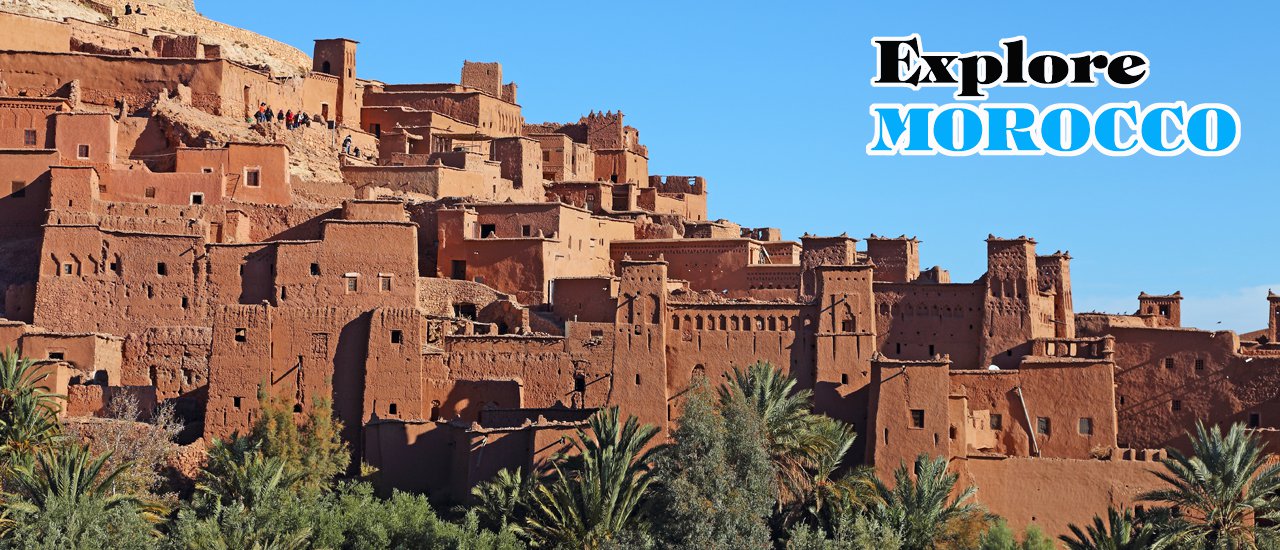Watch the second episode Explore MOROCCO # 2: Travel back in time to the Roman city of Volubilis at https://th.readme.me/p/3010
Watch Episode 3 of Explore MOROCCO # 3: **Entering the alleys and exiting the alleys in Fes** at https://th.readme.me/p/3011
Watch Episode 4 of Explore MOROCCO #4: Sky Meets Sand at Merzouga at https://th.readme.me/p/3012
Today's program, we will travel from Merzouga to Ouarzazate. We did not choose to rent a car because we will go straight to Ouarzazate without stopping along the way. Therefore, choosing to use the bus service is the best option because it saves the most money on travel.

The driver dropped us off at the bus station, which was the same station and company we used to travel from Fes to Merzouga.

The bus fare from Merzouga to Ouarzazate is 145 Dh. The bus departs at 8:00 AM.


The scenery on both sides of the road kept me entertained throughout the journey. This type of terrain is not found in our country. We passed through oases and palm groves.

The Atlas Mountains, a mountain range in northwestern and northern Africa, stretch from the southwestern coast of Morocco at Agadir Bay on the Atlantic Ocean to the northeastern coast of Tunisia. The mountain range is approximately 2,500 km long. During the winter, the Atlas Mountains are covered in snow.

Passing through small towns, letting us press the shutter all the way.

The bus stopped at a gas station for passengers to have lunch for about half an hour. Next to the gas station is a restaurant. Judging from the menu, I think the chicken steak would be the best choice for us. This dish costs 50 Dh. I forgot to add the time it takes to cook the chicken steak. It took more than 10 minutes to serve. So we had to eat quickly without talking. I have to admit that this meal was really tiring to eat.

From there, we continued our journey through several more cities before reaching Ouarzazate.
Ouarzazate, dubbed the "Gateway to the Desert," was once a strategic location. In 1928, the French established a military force and developed it into an administrative center. Ouarzazate was the most important city in the south, serving as a connection point for trade routes between the Sahara Desert and cities further north. Today, Ouarzazate is a relatively quiet city that retains its ancient charm.

The bus I was on didn't go all the way to Ouarzazate. Around 4 pm, the driver shouted that we had arrived in Ouarzazate. After getting off the bus, I found a taxi to take me to my accommodation.

The accommodation is located a little outside the city. Tonight we are staying at Dar Rita. The caretaker is a black man. At first he looked scary, but he welcomed us very well.


There is a Welcome Drink which is a mint tea, as well as snacks. There are also oranges available for guests to enjoy. Feel free to grab one if you'd like.

Let's take a look at the atmosphere inside the accommodation.


This room has a single bed. The color of the room looks very vibrant.


Inside the bathroom


The other room is a double bed. The double bed room will look wider than the single bed room, but the double bed is not placed together like in general hotels. But it will be placed according to the room plan more. (Actually, this room can sleep 3 people because 1 single bed is large enough for 2 people and the other bed is a small bed, which can only sleep 1 person) We booked 2 rooms tonight because there is no room for 4 beds here. The price is 60 EUR/room.
Judging from the time, we still have enough time to explore the city of Ouarzazate. From our accommodation, we walked out to the main road and hailed a taxi to take us to the Taourirt Kasbah.






The ceiling and walls of the room are beautifully decorated with colors and patterns.


The top room on the top floor offers a panoramic view of the city of Ouarzazate. You can also see the lake.


Looking at the back of Fort Tarerit, you can see that it is full of many small rooms.

In front of the Tha Rae Tower, there is also a souvenir shop.

On the opposite side of the Taourirt Kasbah is the Musée de Cinema, which houses a small exhibition on the film industry in Ouarzazate. This includes costumes and other props from various films. It's a convenient alternative if you don't have time to visit the larger studios outside the city. However, I didn't personally visit the museum.


The side of the Musée de Cinema is also a place to sell souvenirs.


The city of Ouarzazate is set against the backdrop of the Atlas Mountains. Even without snow, it is still quite beautiful. I can't imagine how beautiful it would be if the mountain tops were covered in snow.
We walked until we were tired and hungry, so we decided to stop for dinner before checking into our accommodation.



For today's meal, I'd like to have steak again. There's beef, lamb, and chicken, served with Moroccan spiced rice. It's quite delicious.




Upon arriving at the accommodation, we took a break at the hotel's guest lounge for a bit. We had some oranges that the hotel had prepared for us before going up to rest.
The next morning, we planned to travel to the city of Marrakesh, but we would also stop by some attractions along the way. Therefore, we hired a large taxi, which was an old Mercedes-Benz model. The taxi fare was 1,200 Dh.

Before we set off, we should probably fill up on some energy.

The taxi was waiting for us in front of the hotel at 8:15 AM. We were ready to start our journey. Along the way, the driver chatted with us. He explained that the word "Ouarzazate" means "No problem" and that most of the people here work in three main industries: tourism, energy, and film. On the way to Marrakesh, we passed several studios. The driver asked us if we wanted to stop and take pictures. Of course, we did!



Along the way, there are shops selling goods, similar to those in our country.

Passing through small towns nestled alongside the Atlas Mountains.


We stopped by Ait Ben Haddou, which is located west of Ouarzazate, on the ancient caravan trade route between the Sahara Desert and the cities of Marrakech and further north. On the way to Ait Ben Haddou, we saw camels waiting to serve tourists.


Ait Benhaddou is a "fortified city" (ksar) or a group of buildings built with red dried mud, surrounded by walls. It was once a residential community, located on the left bank of the Mellah River, which is usually dry except during winter and spring.


Ait Benhaddou is renowned for its imposing kasbahs, a series of fortified villages built in succession. These structures were constructed by warrior tribes who controlled the Atlas Mountains, creating a fortified city.





The kasbah is a square-shaped building made of sun-dried mud bricks or red bricks, and may be mixed with dry grass or straw. It has thick and high walls surrounding the kasbah. Most of the walls have small holes for people inside to look out, but people outside cannot see inside. Inside the group of buildings in the kasbah, there are many different rooms, such as living rooms, kitchens, and rooms for storing crops. The doors are all made of wood and can only be opened from the inside.

At the four corners of the kasbah, there are tall towers used for reconnaissance and defense against enemies. The kasbah therefore looks like a castle with fortifications and surrounding walls. Currently, the condition of Ait Benhaddou has been severely damaged by strong winds and heavy rain.


Across the river from Ait Benhaddou is the new town, where the indigenous people who moved out of Ait Benhaddou now reside. The Mellah River, which is nearly dry, separates the old and new towns. The new town is now home to residents and a growing number of hotels. If you plan to stay in Ouarzazate, I recommend staying in this area because you will be able to experience both the sunset and sunrise.


Ait Benhaddou has been used as a filming location for many famous movies, such as Lawrance of Arabia, Jesus of Nazareth, and Gladiator.


UNESCO has declared Ait Benhaddou a World Heritage Site since 1987. The entrance fee is 10Dh per person.


The route winds its way up a steep path that hugs the mountainside.

There are rest stops along the way as well.


The unusual landscape made it impossible for me to resist asking the driver to stop for a photo.


Nestled amidst the mountains, there lies a village surrounded by towering trees that have now unanimously changed their colors from green to brown, leaving a sense of aridity in the heart.

The old Taxi that brought us from Ouarzazate was in such a state that whenever the driver hit the brakes, we could feel the car's imperfections as we descended the mountain and navigated the curves. I prayed silently that nothing would happen to us along the way.
Follow Explore MOROCCO #6: Marrakesh, the Great City of the Maghreb, at https://th.readme.me/p/3022
ลุงเสื้อเขียว
Friday, September 27, 2024 9:51 AM










